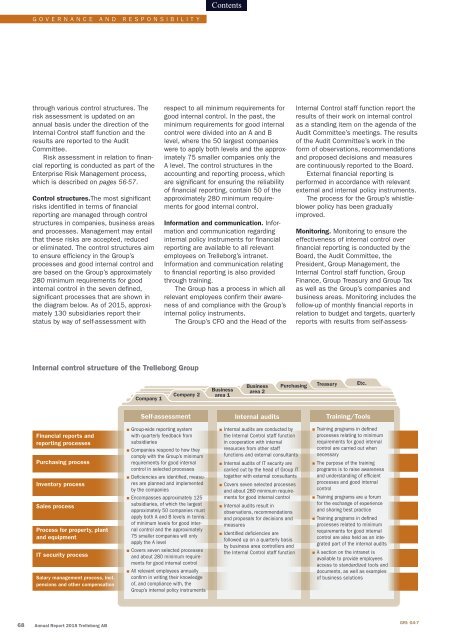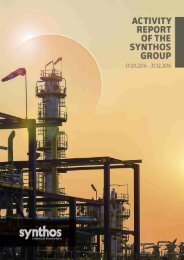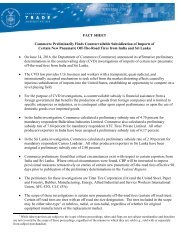We seal damp and protect
1o0Rrof
1o0Rrof
Create successful ePaper yourself
Turn your PDF publications into a flip-book with our unique Google optimized e-Paper software.
GOVERNANCE AND RESPONSIBILITY<br />
through various control structures. The<br />
risk assessment is updated on an<br />
annual basis under the direction of the<br />
Internal Control staff function <strong>and</strong> the<br />
results are reported to the Audit<br />
Committee.<br />
Risk assessment in relation to financial<br />
reporting is conducted as part of the<br />
Enterprise Risk Management process,<br />
which is described on pages 56-57.<br />
Control structures.The most significant<br />
risks identified in terms of financial<br />
reporting are managed through control<br />
structures in companies, business areas<br />
<strong>and</strong> processes. Management may entail<br />
that these risks are accepted, reduced<br />
or eliminated. The control structures aim<br />
to ensure efficiency in the Group’s<br />
processes <strong>and</strong> good internal control <strong>and</strong><br />
are based on the Group’s approximately<br />
280 minimum requirements for good<br />
internal control in the seven defined,<br />
significant processes that are shown in<br />
the diagram below. As of 2015, approximately<br />
130 subsidiaries report their<br />
status by way of self-assessment with<br />
respect to all minimum requirements for<br />
good internal control. In the past, the<br />
minimum requirements for good internal<br />
control were divided into an A <strong>and</strong> B<br />
level, where the 50 largest companies<br />
were to apply both levels <strong>and</strong> the approximately<br />
75 smaller companies only the<br />
A level. The control structures in the<br />
accounting <strong>and</strong> reporting process, which<br />
are significant for ensuring the reliability<br />
of financial reporting, contain 50 of the<br />
approximately 280 minimum requirements<br />
for good internal control.<br />
Information <strong>and</strong> communication. Information<br />
<strong>and</strong> communication regarding<br />
internal policy instruments for financial<br />
reporting are available to all relevant<br />
employees on Trelleborg’s intranet.<br />
Information <strong>and</strong> communication relating<br />
to financial reporting is also provided<br />
through training.<br />
The Group has a process in which all<br />
relevant employees confirm their awareness<br />
of <strong>and</strong> compliance with the Group’s<br />
internal policy instruments.<br />
The Group’s CFO <strong>and</strong> the Head of the<br />
Internal Control staff function report the<br />
results of their work on internal control<br />
as a st<strong>and</strong>ing item on the agenda of the<br />
Audit Committee’s meetings. The results<br />
of the Audit Committee’s work in the<br />
form of observations, recommendations<br />
<strong>and</strong> proposed decisions <strong>and</strong> measures<br />
are continuously reported to the Board.<br />
External financial reporting is<br />
performed in accordance with relevant<br />
external <strong>and</strong> internal policy instruments.<br />
The process for the Group’s whistleblower<br />
policy has been gradually<br />
improved.<br />
Monitoring. Monitoring to ensure the<br />
effectiveness of internal control over<br />
financial reporting is conducted by the<br />
Board, the Audit Committee, the<br />
President, Group Management, the<br />
Internal Control staff function, Group<br />
Finance, Group Treasury <strong>and</strong> Group Tax<br />
as well as the Group’s companies <strong>and</strong><br />
business areas. Monitoring includes the<br />
follow-up of monthly financial reports in<br />
relation to budget <strong>and</strong> targets, quarterly<br />
reports with results from self-assess<br />
Internal control structure of the Trelleborg Group<br />
Company 1<br />
Company 2<br />
Business<br />
area 1<br />
Business<br />
area 2<br />
Purchasing Treasury Etc.<br />
Self-assessment<br />
Internal audits<br />
Training/Tools<br />
Financial reports <strong>and</strong><br />
reporting processes<br />
Purchasing process<br />
Inventory process<br />
Sales process<br />
Process for property, plant<br />
<strong>and</strong> equipment<br />
IT security process<br />
Salary management process, incl.<br />
pensions <strong>and</strong> other compensation<br />
Group-wide reporting system<br />
with quarterly feedback from<br />
subsidiaries<br />
Companies respond to how they<br />
comply with the Group’s minimum<br />
requirements for good internal<br />
control in selected processes<br />
Deficiencies are identified, measures<br />
are planned <strong>and</strong> implemented<br />
by the companies<br />
Encompasses approximately 125<br />
subsidiaries, of which the largest<br />
approximately 50 companies must<br />
apply both A <strong>and</strong> B levels in terms<br />
of minimum levels for good internal<br />
control <strong>and</strong> the approximately<br />
75 smaller companies will only<br />
apply the A level<br />
Covers seven selected processes<br />
<strong>and</strong> about 280 minimum requirements<br />
for good internal control<br />
All relevant employees annually<br />
confirm in writing their knowledge<br />
of, <strong>and</strong> compliance with, the<br />
Group’s internal policy instruments<br />
Internal audits are conducted by<br />
the Internal Control staff function<br />
in cooperation with internal<br />
resources from other staff<br />
functions <strong>and</strong> external consultants<br />
Internal audits of IT security are<br />
carried out by the head of Group IT<br />
together with external consultants<br />
Covers seven selected processes<br />
<strong>and</strong> about 280 minimum requirements<br />
for good internal control<br />
Internal audits result in<br />
observations, recommendations<br />
<strong>and</strong> proposals for decisions <strong>and</strong><br />
measures<br />
Identified deficiencies are<br />
followed up on a quarterly basis<br />
by business area controllers <strong>and</strong><br />
the Internal Control staff function<br />
Training programs in defined<br />
processes relating to minimum<br />
requirements for good internal<br />
control are carried out when<br />
necessary<br />
The purpose of the training<br />
programs is to raise awareness<br />
<strong>and</strong> underst<strong>and</strong>ing of efficient<br />
processes <strong>and</strong> good internal<br />
control<br />
Training programs are a forum<br />
for the exchange of experience<br />
<strong>and</strong> sharing best practice<br />
Training programs in defined<br />
processes related to minimum<br />
requirements for good internal<br />
control are also held as an integrated<br />
part of the internal audits<br />
A section on the intranet is<br />
available to provide employees<br />
access to st<strong>and</strong>ardized tools <strong>and</strong><br />
documents, as well as examples<br />
of business solutions<br />
68 Annual Report 2015 Trelleborg AB<br />
GRI: G4-7






